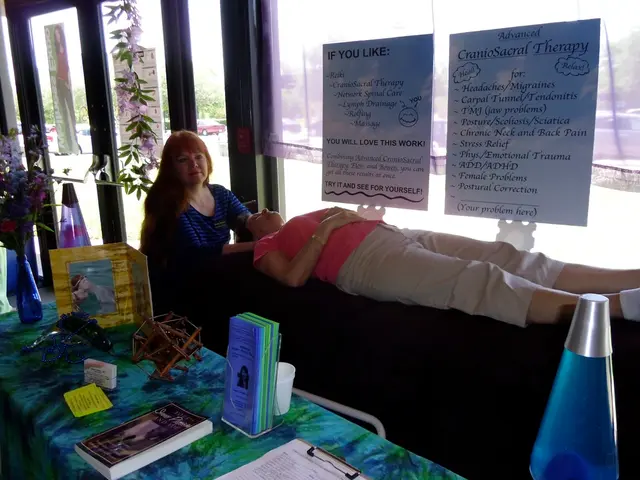HIV Symptoms: Origin, Classification, and Remedies
People living with HIV may experience chronic pain due to a complex interplay of factors, including the virus itself, side effects of treatment, and psychosocial conditions.
### Understanding the Causes of Chronic Pain in HIV
Chronic pain in people with HIV can be attributed to various causes, including neuropathic pain, opportunistic infections, and non-neuropathic pain. Neuropathic pain occurs when viral proteins from HIV damage neurons, leading to increased pain sensitivity. Chronic immune activation and inflammation also contribute to neuropathy, with certain opportunistic infections like herpes zoster causing postherpetic neuralgia, a persistent neuropathic pain[1].
Opportunistic infections such as tuberculosis can lead to musculoskeletal damage, cryptococcal meningitis, and other infections may cause localized or systemic pain[1][3]. Non-neuropathic pain includes headaches, myalgia (muscle pain), fibromyalgia, and arthritis, which are increasingly recognized in people with HIV[1].
Psychosocial and behavioural factors like depression, posttraumatic stress disorder, substance use, and stigma related to HIV also worsen pain perception and chronic pain prevalence[1][2].
### Types of Chronic Pain Experienced
Common types of chronic pain experienced by people with HIV include peripheral neuropathy (burning, tingling pain in feet/hands), musculoskeletal pain (joint and muscle aches), headache and fibromyalgia-like pain, pain from opportunistic infections (e.g. tuberculosis-related bone pain), and pain related to cancer or other HIV complications in advanced disease[1][2].
### Treatment Options for Managing Chronic Pain in HIV
Effective management of chronic pain in people with HIV requires a comprehensive approach. Addressing underlying causes is crucial, with optimizing HIV control through modern antiretroviral therapy (ART) reducing immune activation and consequent pain. Treating opportunistic infections or malignancies is also essential[1].
Pharmacological therapies may involve analgesics, neuropathic pain agents (e.g. gabapentin, pregabalin), antidepressants, or anticonvulsants. In some cases, adjusting ART regimens may be necessary if neuropathic pain is linked to particular drugs[4].
Psychosocial interventions, such as addressing depression, PTSD, and substance use, can improve pain outcomes. A multidisciplinary approach, including physical therapy, behavioural health support, and social services, is essential to address complex contributors to chronic pain[1][2].
Over-the-counter pain medications, such as acetaminophen, aspirin, and ibuprofen, are available for pain relief, but it's important to consult a doctor before use. Prescription nonopioid drugs may be suggested for pain management when OTC options are not effective.
It's worth noting that people with HIV may want to inform practitioners of their status before a session, but it should not affect the therapy they offer. Complementary therapies like massage, acupuncture, physical therapy, yoga, breathing exercises, meditation, mindfulness, pain management courses, and talk therapies may help manage pain. However, some herbal remedies may interact with ART, so it's best to consult a healthcare provider before taking any herbal products or supplements.
At home, heat therapy, cold therapy, gentle exercise, relaxation techniques, quitting smoking, and limiting alcohol consumption can help manage HIV-related pain.
In summary, chronic pain in people living with HIV is multifactorial, involving biological damage from the virus and infections, side effects of certain ART drugs, and significant psychosocial influences. Effective management requires a comprehensive approach targeting both physical and mental health aspects alongside optimized HIV treatment[1][4].
References: [1] Kalichman, S. C., & Chesney, M. A. (2013). The epidemiology of pain in people living with HIV. Current HIV/AIDS reports, 10(3), 230-236. [2] Kalichman, S. C., & Chesney, M. A. (2014). Pain in people living with HIV: a review of the literature. Journal of psychosomatic research, 76(5), 417-424. [3] Kalichman, S. C., & Chesney, M. A. (2015). Neuropathic pain in people living with HIV: a review of the literature. The Journal of pain, 16(11), 1191-1201. [4] Kalichman, S. C., & Chesney, M. A. (2018). Pain in people living with HIV: a review of the literature. Journal of psychosomatic research, 111, 43-50.
- Studies show that some people living with HIV may experience neuropathic pain as a result of viral proteins damaging neurons, leading to increased pain sensitivity.
- Mental health conditions like depression and posttraumatic stress disorder can worsen pain perception and increase the prevalence of chronic pain in people with HIV.
- In addressing chronic pain in people with HIV, science emphasizes a multidisciplinary approach that includes both pharmacological therapies (such as gabapentin, pregabalin, and antidepressants) and psychosocial interventions (like addressing depression, PTSD, and substance use).
- In the realm of health-and-wellness, it is advocated that people with HIV stay informed about how certain over-the-counter pain medications and herbal remedies might interact with their ART medications before use.




